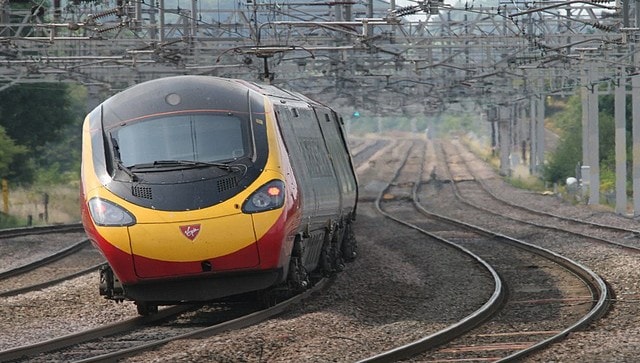India’s railway sector is growing fast. With the introduction of Vande Bharat trains, the country will also get its first tilting trains by the year 2025.
Much like a motorbike moving on a winding road, the tilting technology will enable trains to easily manoeuvre curves without turning their speed down by a notch.
As many as 100 Vande Bharat trains produced over the next few years will be equipped with this technology, hoping to improve their speed.
A PTI report quoted a senior railway official saying, “We will have tilting trains in the country. We will tie up with a technology partner for this. We will have this technology in 100 Vande Bharat trains over the next two to three years.”
Let’s take a closer look.
How do tilting trains work?
It’s all physics.
Usually, when a train takes a turn on a curved railway track, the passengers and objects (like luggage) inside tend to shift their positions and are subject to lateral forces. Seated passengers feel squashed to one side of the train while standing passengers lose their balance.
But, in tilting trains, this effect, which is often discomforting, is counteracted. A tilting train employs a motion control technology that enables the carriage to manage the movement of passengers inside.
The design of these trains allows them to tilt towards the curve of a track. The action compensates for the force that is experienced inside the train, especially when its approaching curves at higher speeds.
According to Sweden-based KTH Engineering Sciences, “The basic principle of tilting trains is to roll the car body inwards during curve negotiation in order to reduce the lateral acceleration perceived by the passengers.”

Countries like Italy, Portugal, Slovenia, Finland, among others already have tilting trains. Wikimedia Commons
Apart from keeping the objects and passengers inside a train stable and speeding up railway systems, high-precision tilting systems also allows operators to manoeuvre different accelerating options, optimise operating costs and ensure reliability.
In India, the tilting trains will have a mechanism that will allow them to run at higher speeds on regular broad-gauge tracks.
The rail official said, “As a train rounds a curve at speed, it causes objects to slide about. While it makes the seated passengers feel squashed by the armrest, standing passengers tend to lose their balance. The design of the tilting trains counteracts this.”
Do tilting trains cause motion sickness?
Among the many benefits and advantages of tilting trains, many passengers in countries that already operate such trains have complained of motion sickness.
According to the National Library of Medicine, tests were conducted on eight healthy passengers travelling in tilting trains on a track with the most number of curves. For the purpose of the study, three different cars were evaluated over the course of three days, with each ride lasting for about three hours.
While most volunteers said they had a comfortable ride, 10 per cent of the subjects reported symptoms of motion sickness. A 55 per cent degree of tilt compensation of the lateral acceleration instead of the normal 70 per cent reduced the symptoms of motion sickness by 25 to 40 per cent.
The report also mentions that motion sickness can be essentially eliminated by adjusting the timing of when the cars tilt as they enter and leave the curves. The study found, “When the cars tilt just at the beginning of the curves instead of while they are making the turns, there was no motion sickness.”
Previous attempts at getting tilting trains
This is not the first time India has explored the option of tilting trains.
In 2017, the Railway Ministry inked a deal with Switzerland for developing tilting trains for the country. The two countries signed a memorandum of understanding (MoUs) in this regard.
Two MoUs were signed with the Federal Department of the Environment, Transport and Communications of the Swiss Confederation for technical cooperation in the rail sector in the presence of Prime Minister Narendra Modi.
The first agreement, according to a PTI report, was a follow-up on another bilateral cooperation discussed between the then Railway Minister Suresh Prabhu and the Swiss Ambassador in 2016.
The MoU was aimed at cooperation in areas including traction rolling stock, electric multiple unit and train sets, traction propulsion equipment freight and tilting trains.
Countries that have tilting trains
Countries like Italy, Portugal, Slovenia, Finland, Russia, the Czech Republic, the UK, Switzerland, China, Germany and Romania, already have operational tilting trains.
The tilting trains in Italy, known as Pendolino – meaning pendulum in Italian–, has been manufactured by Alstom Ferroviaria. The trains travel at a maximum speed of 250km/hour. According to Railway Technology, the trains use ‘Tiltronix’ technology and feature hydraulic tilting bogies.
The tilting trains in the UK are operated by Virgin Trains. Starting in 2002, the operator introduced two train systems, namely Bombardier Class 221 Super Voyager diesel trains and Class 390 Pendolino EMUs. The latter has a maximum speed of 225 km/hour and runs between London and Scotland.
With inputs from agencies
Read all the Latest News, Trending News, Cricket News, Bollywood News,
India News and Entertainment News here. Follow us on Facebook, Twitter and Instagram.





